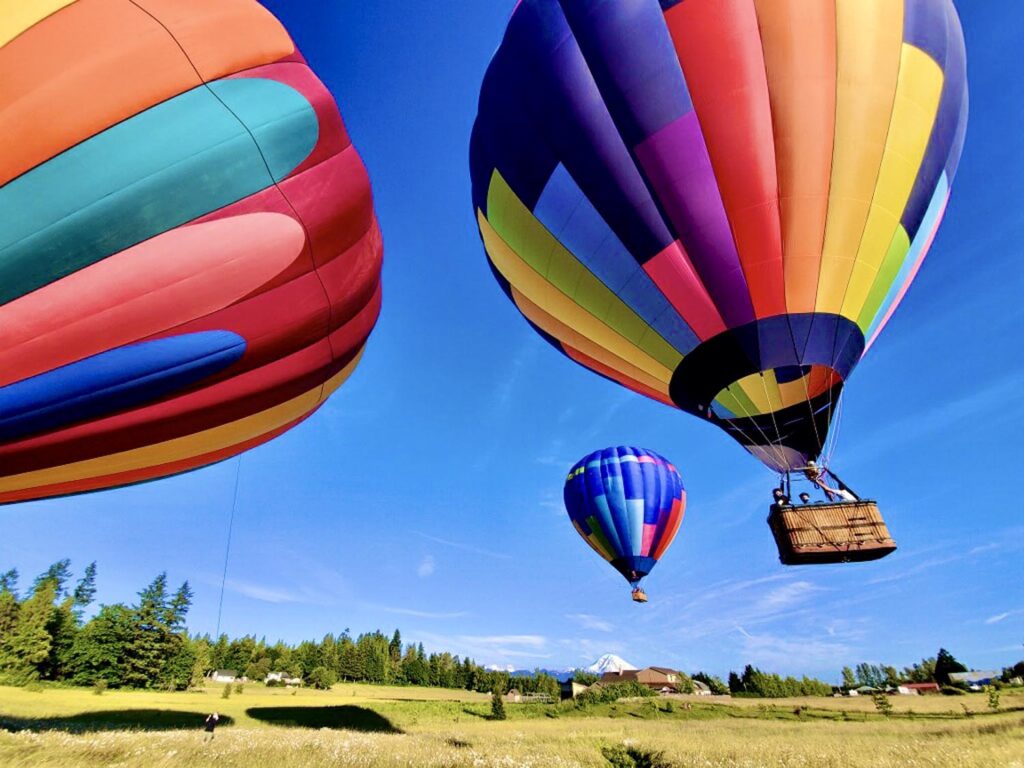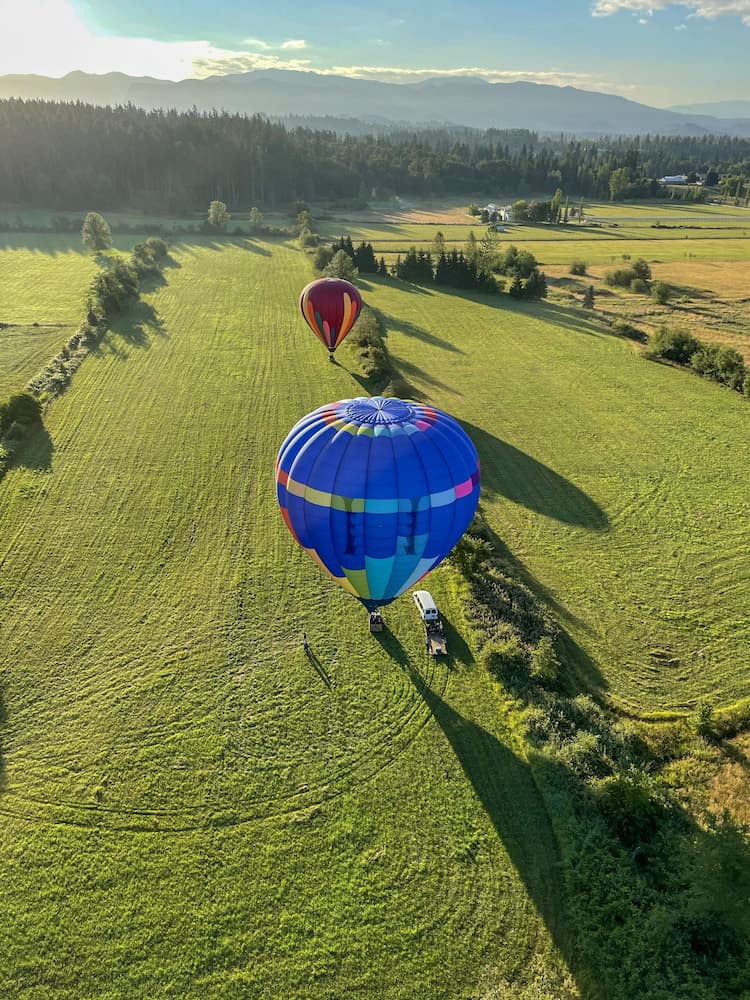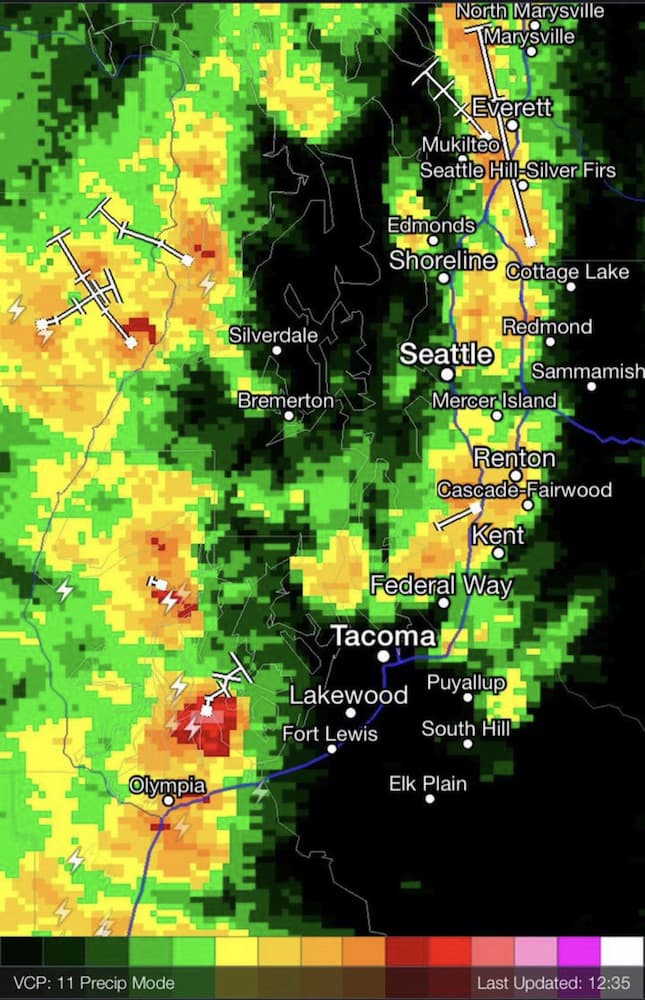Although we’ve been spending a ton of money doing R&D on our weather-controlling device… it hasn’t succeeded. Hot air ballooning is highly dependent on weather conditions, and Seattle, with its diverse weather patterns, is no exception. During the Washington State flying season from April through October, hot air balloons typically do not fly in inclement weather conditions such as rain, fog, high winds, excessive heat, or in the vicinity of thunderstorms. This article should be entertaining and explain why hot air balloon flights are sometimes canceled due to various weather.

What Is Good Weather For Ballooning?
The recipe for good weather for hot air ballooning? A dash of clear skies, a pinch of calm winds, and a sprinkle of warm temperatures, all served up with a stunning view. Good weather for hot air ballooning typically includes calm wind conditions, clear skies, and warm weather. Ideally, light wind speeds should be less than 10 mph, with no gusts present. The temperature should also be mild, typically between 50-85°F, with low humidity levels. In general, most balloon companies only fly at sunrise or within an hour of sunset due to the winds being predictable and calm.
Regarding atmospheric pressure, hot air balloons typically fly best when the barometric pressure is steady or rising. This is because rising pressure can indicate good weather conditions and stability in the atmosphere, making it easier and safer for the hot air balloon to fly. Additionally, good weather for hot air ballooning typically includes clear visibility, with no fog or low clouds that could obstruct the pilot’s view or make it difficult to see potential hazards.
Poor Weather For Hot Air Ballooning
In Seattle, hot air balloons do not fly in the rain, fog, high wind, when it’s too hot, or when thunderstorms are within 100+ miles. Sometimes it’s obvious to everyone that the weather isn’t good to fly that day (raining and a thunderstorm in the area). Other times, the sky is blue and clear of clouds, but still unsafe to fly. Pilots making those safety decisions have a deep understanding of weather and spend a ton of time becoming weather dorks.
Why Are Hot Air Balloon Rides Canceled Sometimes?
Let’s start with the not-so-obvious reasons hot air balloon rides are canceled for weather.

Strong Wind
Wind speed and direction are crucial in hot air ballooning, particularly during the launch, steering, and landing phases. It’s important to note that hot air balloons do not launch balloons with surface winds faster than 10 mph. In general, launching a hot air balloon can be challenging in windy conditions, as the balloon fabric turns into a giant sail and can thrash from side to side. Once in the air, steering a hot air balloon to potential landing sites requires considering the upper and lower wind conditions and ensuring they are not too fast. Fast upper winds can cause pilots to end up in uncommon landing areas and low-level winds and gusts can make landing more challenging. During landing, hot air balloon pilots aim to land in an area with no obstacles, sufficient space, and no farm animals. If Fast landing conditions are present with winds ten mph or higher will require passengers to be trained for faster wind landing positions. A tip-over landing or bumpy landing can be fun as long as passengers follow all safety instructions.
Launching A Hot Air Balloon
Remember being a kid and throwing your jacket high up on a chainlink fence when it was windy out? Now Imagine a ten-story-tall hot air balloon made of fabric in that same wind. Hot air balloons have a challenging time launching in a wind blowing more than ten mph or if wind gusts are present. When inflating in windy or gusty conditions, hot air balloons turn into giant sails and can thrash from side to side until they are successfully inflated or not. Can hot air balloons still go up on windy days? Yes, they need to be launched in appropriate conditions, within the manufacturer’s limitations, and the pilot’s personal limitations and skillset.

Steering To A Suitable Landing Location
Seattle Ballooning has an area of 12 miles total in our flying area. Since hot air balloons only use the upper and lower winds to steer, it’s crucial that the winds at altitude aren’t too fast and go in a direction that makes sense. You can see the general predicted Seattle winds from the ground to 10k feet here.

Landing A Hot Air Balloon
There are two types of landings when flying a hot air balloon. Both are safe and normal. Stand-up landings are where the balloon and basket stand upright. Tip-over landings where there is additional wind. Safety is always the number one factor when landing a hot air balloon. Pilots try to land where there are no obstacles, no farm animals, and in areas with enough room for landing. Fast landing conditions (winds 10+ mph) require passengers to be trained for faster wind landing positions. Although it is possible to land hot air balloons in winds faster than 17mph, it has increased risk. A good rule of thumb is that it will likely be a fast landing if you are launching a hot air balloon in fast wind. You can learn more about how pilots select landing locations in this article

Hot Air Balloons Never Fly In Thunderstorms
I think we all can agree that if there is bad weather and active lighting, you shouldn’t go ballooning. Thunderstorms and severe weather conditions can pose a significant hazard to hot air balloons and all aircraft. Hot air balloon pilots are trained to avoid flying in the vicinity of active thunderstorms, as the strong winds and turbulence associated with these weather events can pose a risk to the safety of the passengers, pilots, and crew. The outflow from thunderstorms, which is an invisible, horizontal stream of air from the base of the storm, can reach speeds of 30-40 mph, making it extremely dangerous for hot air balloons to fly in these conditions. As a result, hot air balloon pilots typically do not fly within 100 miles of a thunderstorm or if there is active radar in the area. To ensure the safety of all involved, hot air balloon pilots closely monitor weather conditions and make decisions based on the latest weather forecasts, radar, and other relevant information.

If It’s Too Hot, You Can’t Fly
If it’s too hot out, it’s miserable to be on a hot air balloon ride. People often ask us if it gets cold when we take a hot air balloon to altitude. The answer is no—the normal lapse rate in temperature decreases by 3 degrees every 1000 feet in altitude. However, the lapse rate is not consistent when it’s hot outside. Additionally, hot air balloons have 20M-30M BTU burners that heat the balloon, causing passengers to feel an additional 10-15 degrees of heat. As a pilot, the high temperatures and heavy air make the balloon sluggish. High temperatures can also cause wind gusts, thermals, and abnormal wind directions when the hot air is pulled into other air masses in the sky.

Flying A Balloon With A Cold Front Approaching Seattle? Not the best idea…
When cold fronts approach, there is often fast wind associated with it. One of the things we do in Seattle is check the areas outside of the Seattle area. We look as far up as Vancouver, Canada, as far East as Idaho, and as far south as Portland. Depending on how strong the low-pressure system is, it may or may not be safe to fly hot air balloons.
A cold front is a dividing line between two contrasting air masses, one cool and the other warm, with the cool air advancing and overtaking the warm air. Cold fronts often result in fast winds, which can complicate hot air ballooning. To guarantee the security of everyone involved, hot air balloon pilots vigilantly monitor weather patterns, including cold fronts that could be approaching Seattle and neighboring regions such as Vancouver, Canada, Idaho, and Portland. Pilots evaluate the power of low-pressure systems linked to the cold front and make well-informed decisions based on this information, as well as other relevant weather data, regarding the feasibility of hot air balloon flights.
The sudden change in weather conditions can visually recognize a cold front as it moves through an area. In front of the front, warm and moist air can create clouds and showers, while behind the front, cooler and drier air can bring clear skies and rapid temperature shifts. Low-pressure systems related to cold fronts can also bring strong winds, particularly in the vicinity of the center of the system, which can pose challenges for hot air ballooning.
Can A Hot Air Balloon Fly In The Rain?
Although fixed-wing aircraft can fly in the rain, hot air balloons don’t typically fly in the rain. The rain isn’t great for the hot air balloon fabric, and the weather associated with rain isn’t safe to fly balloons in. As professional commercial hot air balloon pilots, we do not fly if there are any radar pops or thick clouds full of moisture in the Seattle area.

Low Clouds, Onshore Flow, and Fog
Hot air balloons are governed by the FAA and must follow VFR rules (visual flight rules). Any aircraft regulated by VFR rules isn’t allowed to fly through clouds, must stay 500 feet below a cloud, or 1000 feet above. Although legally hot air balloons can fly if the clouds are at 1500-2000 feet in class G or E airspace, it’s not a great flight. Most people fly with Seattle Ballooning because they want to see Mt. Rainier from the sky. Hot air balloons also can’t fly if there is fog on the surface, as it makes it impossible to see powerlines and other hazards. Fog occurs when the temperature and dewpoint are the same. Fog can be a hazard to aviation because it typically doesn’t appear on radar. The Washington Weather Discussion, supported by the University of Washington, gives pilots insight into the possible fog, onshore flow, and low clouds.
Why Else do Hot Air Balloon Rides Get Canceled Besides The Weather?
Are there other reasons we cancel flights? Yes. The safety of our passengers, pilots, and crew is our number 1 priority. Our pilots are not superheroes. They get sick from time to time, get exhausted, have a gut feeling they shouldn’t fly, or have uncontrollable things that happen in their lives. Choosing to launch that day or not is always the choice of the individual pilot. As a business, we support those pilots in their safe decision-making.

